I encountered many knitting books in 2012, but this was my favourite by far. Unlike so many books that have recently been written about Shetland, and Shetland knitting (my own included) this one has been produced by Shetlanders themselves. And not just by any Shetlanders. I don’t think it is going too far to say that the group of women behind this book are among the best knitters in the world. Their work is certainly the very finest that Britain has to offer. In this wonderful tome, key members of The Shetland Guild of Spinners, Knitters, Weavers and Dyers share their knowledge of the old traditions and contemporary practice of Shetland fine lace knitting. It is a timely publication. I have had cause to complain here several times about the misleading rubbish that is often peddled under the name of knitting ‘history’ and, unfortunately, Shetland textile traditions have suffered more than most in this regard — partly due to bias and poor scholarship, and partly too because Shetland’s knitter-designers tend to focus their talents on their needles rather than on the printed page. But here, we see the beautiful work, hear the articulate voices, and are able to work from the stunning patterns of Shetland’s wonderful knitter-designers. In so many ways, this book is their gift to the rest of us, and a very welcome gift it is too.
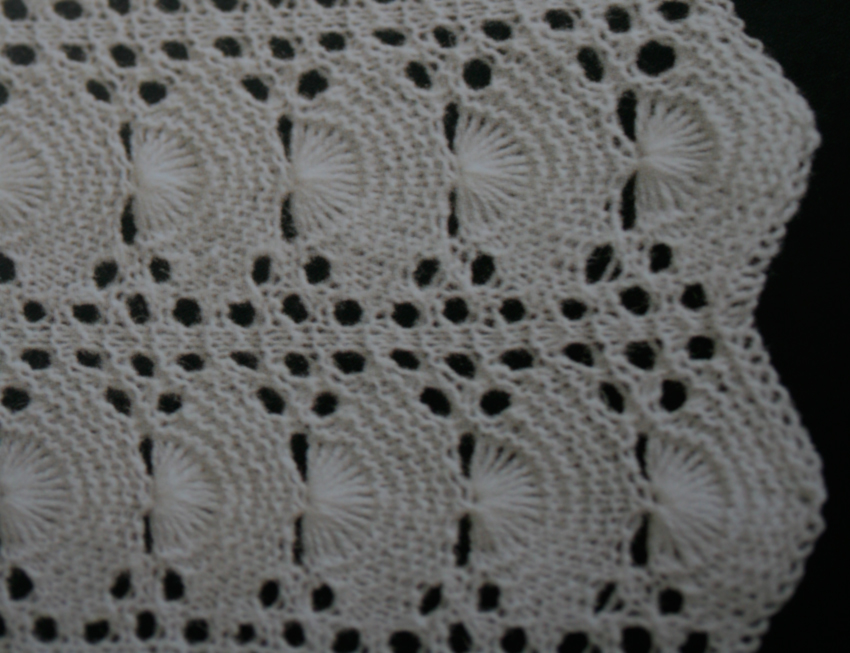
(Shelley Scarf, designed by Lauretta Robertson)
The book includes a balanced collection of 21 designs. These range from familiar and simple Shetland openwork patterns (such as those that appear on Zena Thomson’s borders-in Traditional Hap, or Lauretta Robertson’s Shelley Scarf) to dazzling showcases of the finest of fine Shetland lace (such as Susan Johnson’s breathtaking Chapelside Stole, or Mary Kay’s St Ringan’s Scarf). There are also a couple of lovely lace garments to knit. No-one designs a yoked sweater better than Hazel Tindall, and her Gairdins Top is a very fine example. I also found myself drawn to Lauretta Robertson’s Laureya Cardigan , with its neat and pleasingly structural allover stitch pattern.
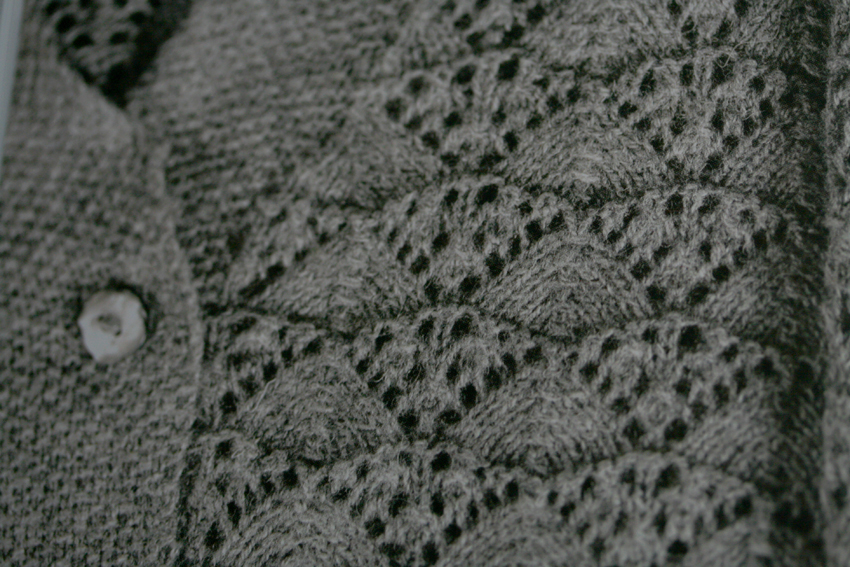
(Detail of Lauretta Robertson’s Laureya Cardigan )
Photographing fine lace can be very tricky, and Dave Donaldson has done a great job here. Most of the designs have been carefully pictured on blank, dark backgrounds. Close-ups help the reader / knitter to understand the rhythm of the designs, and provide useful visual cues to the accompanying charts.
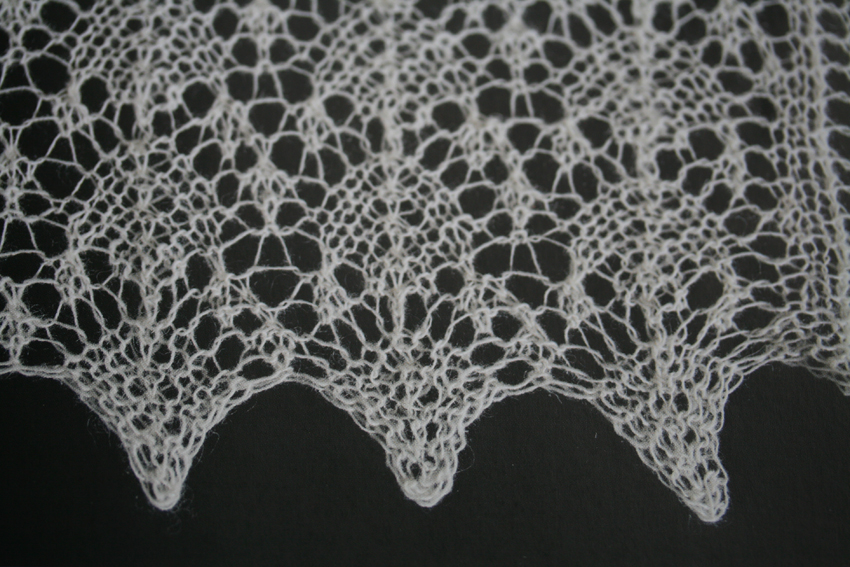
(Close up of edging of Zena Thomson’s Vaga Scarf).
The charts are large and well laid out, and the patterns clearly written and explained.
One aspect of Shetland knitting that non-Shetlanders are often bamboozled by is its basic equipment. How are long wires and a makkin belt really used? What exactly is a woolly board? One of the many lovely things about this book is that the women involved in it have taken time to illustrate and explain these mystifying objects . . .
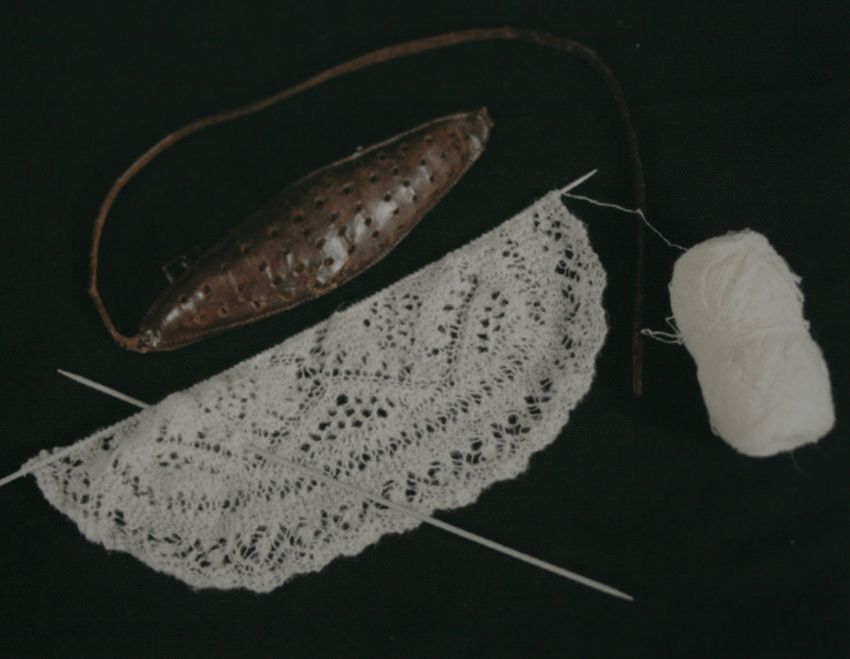
(The beginnings of Zena Thomson’s Gilda Scarf pictured with a makkin belt)
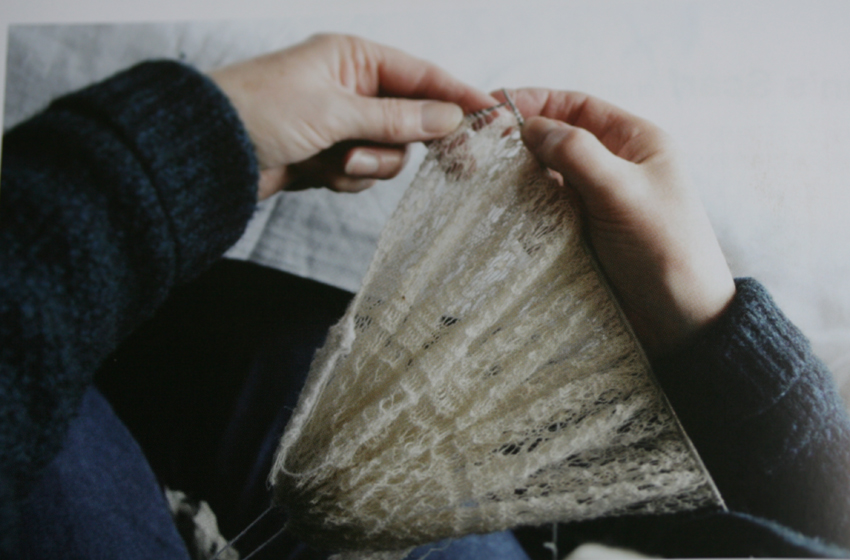
(lace tethered to the belt with a ‘raepin string’ to create tension )
Included here are also instructions for different methods of blocking and stretching (careful finishing really is crucial in all kinds of Shetland knitting), and there’s also a useful glossary of Shetland knitting terms unfamiliar to most of us. If you don’t know what “wrang loops” are or what it means to “spret” your knitting, here is the place to find out.
In amongst the designs and patterns, you’ll also find informative and witty anecdotes, together with interesting explanations of other knitting-associated dialect terms, all of which lends the book a distinctive Shetland flavour.
There are many things to love and admire about this book, but one of its most enjoyable aspects for me was reading the brief biographies of each designer. All of these women are truly amazing award-winning knitters, but I know from having met several of them that they can also be modest to the point of total silence about their considerable talents. Through their short biographies, we learn about what knitting has meant to them, about their own aesthetic tastes and predilections, and much more generally about a community in which lace knitting developed its own particular practices and economy, and played (and indeed continues to play) a crucial role in the lives of many women. Shetland knitters should be proud of their legacy, and it is wonderful to see that pride evidenced — albeit quietly — in the hopes that each designer expresses here for the book to which they have contributed. Winne Balfour hopes “that this book may encourage young knitters to take an interest in and enjoy learning, developing and continuing the skills of the legacy we have been left.” Zena Thomson hopes “that the clear patterns and photographs in this book will help people to try out patterns they might otherwise not have tried.” Pearl Johnson “is very glad that this book has been produced by folk living and knitting in Shetland and hopes that it will raise more awareness of Shetland traditional knitting,” and Susan Johnson “hopes this book reaches everyone interested in Shetland, Shetland lace and knitting, and that they receive and appreciate the spirit of quiet enjoyment that produced it.” That quiet enjoyment is evident on every single page of this great book, which should have pride of place on every knitterly bookshelf.
Shetland Guild of Spinners, Knitters, Weavers and Dyers, A Legacy of Shetland Lace (Lerwick: Shetland Times LTD, 2012). ISBN 978-1-904746-76-8
*You can buy A Legacy of Shetland Lace directly through the Shetland Times Bookshop or from Jamieson and Smith.
*And did you know that the Shetland Guild of Spinnners, Knitters, Weavers and Dyers have their own Ravelry Group?

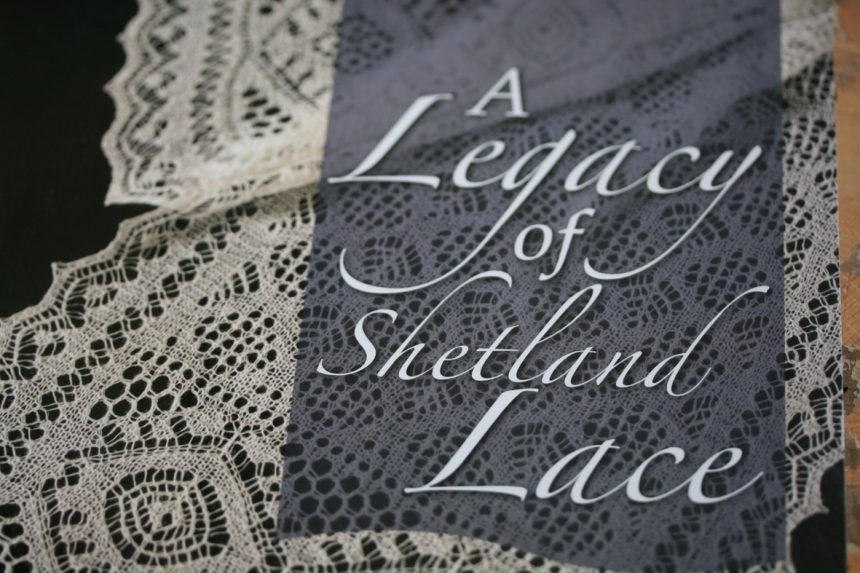
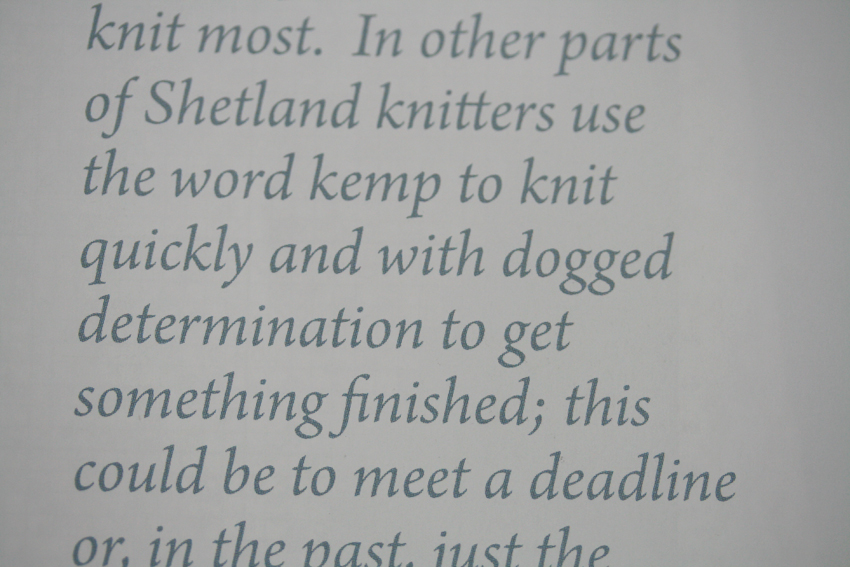
Going to Shetland for a couple of days in May. Thought I might buy this book when I come there – but who just ordered it from Shetland Times – I did! Looking forward to see it!
LikeLike
As others have said, thank you for the review of the ‘Legacy..’ Yesterday I ordered it from J&S along with some clews of 2 ply lace yarn (that there wasn’t time to spin). I’m currently knitting a Shetland shawl for an old lady, who will gift it to the parents of her expected first great-grandchild. In the early 1970s I spent a summer in Shetland, working and knitting with the local women. One of the experiences in life that I’ve been most grateful to have had.
LikeLike
I’d been hoping to come across a review of this book. Thank you!
LikeLike
On behalf of the publishsers, thank you for such a great review. Kate is right that supplying Amazon is not financially viable for us. However, a shipment of the book has been sent to the US and should be available through Unicorn Books and Crafts imminently.
LikeLike
Thank you, Kate, for this fantastic review. I will make sure the contributors get to see it! Our big disappointment is that we inadvertently missed out Ina Irvine’s biography. We have also noticed/been told about some other small errors. There is a group page for Shetland Guild of Spinners, Knitters, Weavers and Dyers on Ravelry where you can find Ina’s biography and errata.
LikeLike
Perhaps that missing biography could also appear as an addendum to this blog post?
LikeLike
So beautiful and tender! I love knitting lace more than anything else! Yes, it takes more time, but it looks like anything else in the world! Thanks for sharing this book review :) I’ll try to figure out a way to bring this book to Japan ^^
LikeLike
What a wonderful review!! This is on my list. I wonder if you can purchase the “olde tools” at any of the yarn/wool shops in London? Comments!!
LikeLike
Cleary, this is a MUST HAVE book, even if difficult to get hold of here in Canada. I certainly intend to try to get my hands on a copy.
LikeLike
I surely would love to try a makkin one day…. none of that sort of thing is on the West Coast of US . I asked a very popular ‘young – thinking and educated staffed’ knitting store here about if they had access to them, they had no clue what a makkin was. I had to explain…nor did they know what long dp needles were. Oy. This stuff apparently is too old-world quirky (though I say that like its a good thing) … and still not trending with the modern knitters here. :)
LikeLike
I’d like to learn to knit. I learned to crochet a couple of years ago and I’d like to try knitting next. But I’d prefer to learn the really old traditional way. I am reading ‘Old Handknitters of the Dales’ which says they used knitting sheaths and other gubbins like the makkin belt pictured above and could knit really fast and as they walked about etc. This is what I would like to learn! Would this book be a suitable starting place, or is there one anyone could recommend please?
LikeLike
Your review took my breath away, I can’t imagine what the book will do! I’m planning a purchase from J&S next month to knit some of the items from your Colours of Shetland book, I’m definitely adding this beautiful sounding lace book to my order. Thank you for sharing it with us.
LikeLike
Oof, I love your blog! The combination of history, beautiful designs, and fantastic recommendations has made it my favorite blog.
Thank you so much for sharing this book! I’m hoping to take a trip to the Shetlands this spring (I live in the US) and this only fueling it further.
LikeLike
Thank you Kate. This lovely book is now on its way to my bookshelf!
LikeLike
What I love and appreciate most is the voices of other knitters, who inspire us all with history, wisdom, knowledge, and dedication. Oh MY!!! I will order this and admire them from afar, even though I too am intimidated about what they do. Please say Thank You from all of us! and thanks, Kate, for sharing this wonderful addition to our understanding of the shoulders we stand on!
Bless them all!
LikeLike
I’ve lost my knitting mojo recently – but this could get me back on track (except of course I’m not supposed to be buying books ……. but I might just be blogging about one tomorrow!!)
LikeLike
American readers may like to know that I’ve just contacted Schoolhouse Press and learned that they will be stocking this title. They aren’t sure of its arrival date, but it will be ready for preorder on their website soon! Check back at schoolhousepress.com.
LikeLike
Oh, how I dislike knitting lace. But, oh, how I love seeing the magic that lace knitters can create on their needles. Thank you for such a well done review. I think this one is a buy-for-reference book for me rather than a book where I will actually knit a pattern. However, my Betty Mouat cowl kit just came and if I can do that justice, perhaps I can knit the shell scarf as well.
LikeLike
I’m so glad you are sharing this with your followers…I first came across it on the Shetland.org site and kept checking with the Shetland Museum but wasn’t able to purchase it there. I emailed directly to the Guild and was directed to Shetland Times Bookshop, {www.shetlandtimes.co.uk} from whom I purchased this book and of course several others. The bookshop have a wonderful array of books to chose from, on many different subjects…worth checking out.
I then had to knit the Traditional Shetland Hap, so I can wear it during our Scotland/Shetland holiday. It is a stunning book and your review is wonderful. For all those who purchase one, please do send on an email to the Guild { sgswdk@yahoo.co.uk } who is responisble for this stunner (as I did); they deserve to hear the thanks/praise for themselves. Thank you for sharing it Kate and thanks to them for making it!
LikeLike
as a non-knitter , or a knitting voyeur, if you will, i have never been more compelled by your work, dr. davies, than when you analyze pinny porn or knitting history. i’m still trying to wade through the material culture book — A Sense of Things, Bill Brown — this blog introduced me to, and am looking forward to more of that from you. the artifacts of it all, and your sense that those who know how to make shetland lace are the last to write books about it makes me know you are absolutely on the right track.
thanks for it all.
LikeLike
Hi Jeannette!
Please get thee to a yarn shop soon! Any knitter will be happy to sit beside you and get you started. I am wishing you well! Once you begin, you will be so happy!
LikeLike
Definitely need this book; it looks wonderful. Members of the Guild made us (three mad members of the Llyn Guild) so welcome when we visited, and passed on so many useful tips.
I swore I didn’t need any more knitting books, but I was clearly deluded…
LikeLike
Hello Kate, I totally concur that this is a great book. On my first perusal, I stopped with tears in my eyes at the beauty of this lace. I don’t think that has ever happened before! Lovely work indeed.
LikeLike
YES YES::::::please keep passing on your colours + inspiration + book titles x-x-x-x
your faithful knitter in Oregon,
teri —x
LikeLike
A fantastic and thorough review as always, Kate. This looks like a book that belongs on my shelf!
LikeLike
I like your Review of the book and although I prefer colorwork and cables, the beautiful lace patterns make me want to give the technique a second look!
LikeLike
HA, just as I Resolved to not spend any more knitting/weaving/spinning $$ this month along comes this!!! There is always next month, super. Something to look foreward to. Thank you so much for your review and alerting us to this wonderful publication.
Yes, the new banner is super!
LikeLike
Lovely book description with many helpful details. I consider myself a student of Shetland knitting and am very much looking forward to this book. I raise Shetland sheep and will earmark some fleeces to spin up to have a go at one or more of the appealing projects in this book.
LikeLike
Kate, before I even read your post I must tell you how much I LOVE your new banner photo! Just beautiful :)
(Now back to read the post…)
LikeLike
I love this book. I’ve just finished my first piece from it. I ordered my copy directly from the Shetland Times – their website has a bookshop. It shipped to Australia without delay.
I, too, loved the stories the women told about their own knitting histories, and was delighted to read the Shetland terms. I did indeed have to ‘spret’ my Kirk Ness Scarf, back 40 rows. I don’t know how I missed the error earlier. Such is knitting!
LikeLike
I have always been intimidated by knitting lace. However, I am fascinated by the history of hand crafts & forever infatuated by the bond I feel women who have lived before me crafting each stitch they knit with love. I wonder how I can feel this way & yet live a life never attempting lace. I guess I’ll have try it out. It surely can not be as difficult as it appears. This book may be a good starting place.
LikeLike
It is NOT as difficult as it appears Carrie so get those knitting needles out and give it a go. This is a brilliant book…………totally agree with Kate’s review.
LikeLike
Glad to hear of a new and true source for Shetland Lace. Looks like this will be an addition to my library. Thanks for the great review.
LikeLike
Excellent review Kate! Made me want to go right out and buy it. Unfortunately Amazon/US has it as out if print. Since its publication date was October 2012, I hardly see how that’s possible. Any ideas on how to find the book here in the USA?
LikeLike
Amazon are such a hideous commercial behemoth, and undercut small publishers by such a large amount that it often isn’t worth listing with them. For precisely this reason, I decided not to sell my book via Amazon – which is why it is listed as ‘out of print’ with them, and perhaps the Shetland Times did the same with A Legacy of Shetland Lace . . . I would email the Shetland Times directly and inquire about their US distributors or stockists.
LikeLike
Good to know. Thanks.
LikeLike
For US readers, lacis.com stocks the book (as well as a pretty spectacular collection of lace knitting books and patterns from around the world).
LikeLike
An excellent review Kate, I have seen the book but haven’t purchased it yet- it will be the next knitting book I get!
LikeLike